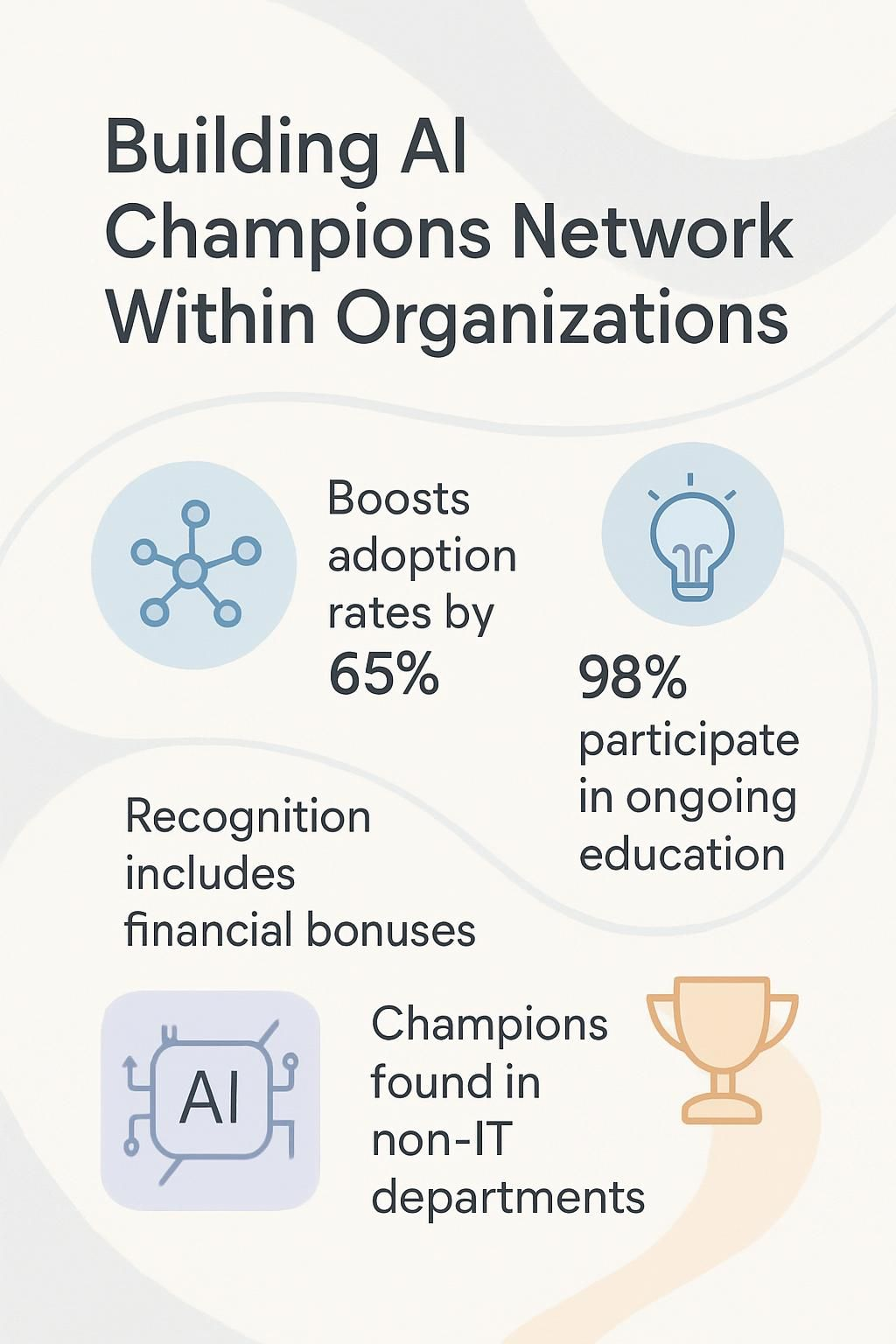Building AI Champions Network Within Organizations


Understanding AI Integration

AI champions act as the secret sauce in organizations that successfully adopt artificial intelligence. These tech-savvy individuals spread AI knowledge across departments and turn complex concepts into practical applications.
Companies like Adobe and Salesforce have built networks of up to 500 champions who drive innovation and integration throughout their businesses.
AI champions combine technical skills with business know-how. They need programming knowledge, strategic thinking, and a healthy dose of curiosity. About 98% of effective champions participate in ongoing learning programs.
Organizations use various training methods including the WRITER AI Academy and hackathon competitions to keep their champions sharp.
The impact of these networks is measurable. One company reported $100 million in cost savings from their AI initiatives. Others track metrics like project pipelines, activity counts, and employee engagement.
For example, one organization's 46 champions successfully connected with 50,000 employees.
Smart companies follow a "Crawl, Walk, Run" approach to building their AI culture. They start by assessing readiness, then establish champion networks with clear policies.
Only 21% of companies currently have GenAI policies in place. The most successful programs focus on ethical principles and data privacy while encouraging cross-departmental collaboration.
As Reuben "Reu" Smith, founder of WorkflowGuide.com and AI automation strategist, has seen after building over 750 workflows, champions need proper motivation. Top performers often receive financial incentives, while others respond to gamification elements.
Sharing success stories, like AI-powered chatbots or Shark Tank-style innovation programs, builds confidence across the organization.
Ready to transform your company with AI champions? Let's get nerdy.
Key Takeaways
- Companies with AI champions networks boost adoption rates by 65%, transforming skeptics into believers through practical demonstrations and quick wins.
- Effective AI champions possess both technical aptitude and communication skills, serving as bridges between IT teams and business departments.
- Look beyond IT departments for champions - hidden talent often exists in marketing, accounting, and HR teams who show natural interest in AI solutions.
- Training should mix formal instruction with hands-on experience, with 98% of successful champions actively participating in ongoing education.
- Recognition programs that include financial bonuses, public acknowledgment, and special access to new AI tools keep champions motivated and engaged.

Understanding the Role of AI Champions

AI Champions serve as the bridge between technical AI capabilities and practical business applications. These tech-savvy individuals drive AI initiatives forward by translating complex concepts into language that resonates with different departments.
Think of them as your organization's AI ambassadors, equipped with both technical know-how and people skills to spread AI literacy throughout your company. They don't just talk about AI; they actively demonstrate its value through real-world applications that solve specific business problems.
AI Champions aren't just tech enthusiasts; they're organizational translators who turn AI potential into business reality.
The most effective AI Champions excel at stakeholder engagement and cross-functional collaboration. They connect IT teams with marketing, operations, finance, and other departments to create a unified AI strategy that aligns with company goals.
I have observed how these champions transform skeptics into believers by showcasing quick wins and addressing concerns head-on. They build trust through knowledge sharing and transparent communication about both the possibilities and limitations of AI tools.
Their role goes beyond implementation to include change management, helping teams adapt to new workflows while maintaining focus on meaningful human work rather than just adding shiny tech toys.
Want To Be In The Inner AI Circle?
We deliver great actionable content in bite sized chunks to your email. No Flim Flam just great content.

Identifying and Recruiting AI Champions
Finding AI champions requires a strategic approach to spot tech-savvy employees who show genuine interest in artificial intelligence. Your organization likely has hidden AI talent in departments you'd never expect – from accounting wizards who dabble in Python to HR folks who've built their own chatbots on weekends.
Qualities to Look for in AI Champions
Spotting the right AI champions can make or break your digital transformation efforts. These tech-savvy trailblazers need specific traits to drive AI adoption across your organization.
- Genuine passion and curiosity for AI technologies. Your champions should get excited about new AI tools the way I get excited about a perfectly automated workflow (which is very excited, trust me).
- Technical aptitude balanced with business understanding. Look for people who can explain machine learning concepts to your marketing team without making their eyes glaze over.
- Strong communication skills to translate complex AI concepts into business value. The best champions can explain neural networks using Star Wars analogies that actually make sense.
- Problem-solving mindset focused on real business challenges. Your ideal champions see problems as puzzles waiting for AI solutions, not roadblocks.
- Change management skills to help teams embrace new ways of working. AI champions need to be part cheerleader, part therapist for colleagues afraid of robot overlords.
- Strategic thinking abilities to align AI initiatives with business goals. The 500 champions we trained in creative problem-solving all shared this critical trait.
- Collaborative nature that breaks down departmental silos. Great AI advocates build bridges between tech teams and business units faster than you can say "cross-functional synergy."
- Continuous learning habits to stay current with rapidly evolving AI. Your champions should have browser histories full of AI research papers and tech blogs.
- Data literacy skills to understand the fuel that powers AI systems. Champions must know good data from garbage data without needing a data scientist to explain it.
- Resilience in the face of setbacks and implementation challenges. AI projects rarely go perfectly the first time, so your champions need to bounce back from failures.
- Ethical awareness regarding AI applications and implications. The best thought leaders consider not just if we can use AI, but if we should.
- Practical implementation experience with AI tools. Theory is nice, but hands-on knowledge separates true champions from AI tourists.
Now let's explore effective strategies for recruiting these AI champions across different departments in your organization.
Strategies for Recruitment Across Departments
Now that you know what to look for in AI champions, let's discuss how to find these tech-savvy individuals throughout your company. Recruiting champions across different departments requires strategic planning and thoughtful outreach.
- Host AI discovery workshops where staff can explore new tools in a relaxed environment. These sessions often reveal hidden talent who naturally gravitate toward tech solutions.
- Create a simple nomination process where managers can suggest team members who show aptitude for learning new systems. One financial services company found 40% of their champions through manager nominations.
- Expand your search beyond the IT department for champions. Marketing teams often contain data-driven creatives who adapt quickly to AI tools.
- Develop a clear value proposition tailored to each department. Sales teams might appreciate AI that qualifies leads faster, while operations staff value automation that reduces manual tasks.
- Collaborate with HR to include AI aptitude questions in job interviews for all positions. This sets the foundation for future champions in every new hire.
- Initiate an internal "AI challenge" where staff can submit ideas for process improvements using AI. This identifies problem-solvers across departments.
- Organize lunch-and-learn sessions where current champions share their successes. Peer success stories attract new recruits more effectively than executive mandates.
- Create a digital suggestion box for AI applications. The quiet accounting specialist might have excellent ideas but needs a low-pressure way to share them.
- Form cross-functional innovation teams that meet monthly to discuss AI opportunities. This creates natural recruitment channels across departments.
- Enhance existing talent development programs by adding an AI track. This engages staff already identified as high-potential.
- Analyze system usage data to identify early adopters of new tech tools. These digital natives often make excellent champions without formal recruitment.
- Engage with department heads to understand specific challenges that AI might address. This targeted approach builds stakeholder engagement from the start.
Training and Empowering AI Champions
Training AI champions requires more than just technical skills—it demands a mix of leadership development and hands-on experience with real business challenges. Your champions need practical tools they can use tomorrow, not theoretical knowledge that gathers dust like that Star Wars collectible you swore would pay for retirement someday.
Providing proper training sets the stage for effective AI advocacy. The approach embraces both structured courses and project-based learning.
Providing the Right Tools and Resources
- Comprehensive AI learning platforms with self-paced courses adapted to different skill levels. Adobe and Salesforce have seen significant success with this approach in their ambassador programs.
- Regular access to industry webinars and virtual conferences keeps champions informed of AI developments without exceeding your budget.
- Subscription services to premium AI tools that allow champions to experiment and build proof-of-concepts before company-wide implementation.
- Dedicated time allocation (10-15% of work hours) for AI exploration and project development creates space for innovation without overwork.
- Internal knowledge base or wiki where champions document learnings, successes, and challenges for the benefit of the entire network.
- Sandbox environments that let champions test AI applications safely without risking production systems or data integrity.
- Budget for certification programs that validate their expertise and increase credibility when promoting AI initiatives across departments.
- Communication channels like Slack groups or Microsoft Teams spaces specifically for AI discussions and quick problem-solving among champions.
- Access to real business data (properly anonymized) enables champions to create relevant use cases that solve actual company problems.
- Mentorship connections with external AI experts who can provide guidance on complex challenges beyond internal knowledge.
- Template libraries for common AI workflows save time and create consistency across champion-led projects throughout the organization.
- Visualization tools help champions present AI concepts and results to non-technical stakeholders in compelling, easy-to-understand formats.
- Regular skill assessment tools identify knowledge gaps and guide personal development plans for each champion.
- Case study database from successful AI implementations at other companies offers inspiration and practical application ideas.
- Investment in employee training resources has shown to maintain expertise and encourage collaboration across teams.
Establishing Continuous Learning Opportunities
Lifelong learning forms the backbone of any successful AI champions network. Data shows 98% of effective AI champions actively participate in ongoing education programs that keep their skills sharp as technology races forward.
At WorkflowGuide.com, companies have struggled when they treat AI training as a one-and-done workshop rather than an ongoing journey. Think of it like leveling up in a video game; you can't defeat the final boss with level 1 skills! Professional development must combine structured courses with experiential learning opportunities that connect directly to daily work challenges.
Creating a knowledge-sharing ecosystem multiplies the value of individual learning efforts across your organization. Smart companies host regular hackathons and innovation contests that turn theoretical ideas into practical solutions for real business problems.
One client increased their automation adoption by 42% after implementing monthly "Nerd-Out" sessions where AI champions demonstrated recent wins and shared lessons learned. Training programs work best when they mix formal instruction with hands-on projects that tie directly to operational challenges.
Creating a Collaborative AI Network
AI champions work best when they connect across departments to share wins and tackle challenges. Your network needs formal meetings as well as informal channels, like dedicated Slack groups, where champions can quickly share ideas and solve problems.
Encouraging Cross-Departmental Collaboration
Breaking down departmental silos can merge distinct teams into a unified force for innovation. Cross-functional AI collaboration fosters both advocacy and networking by encouraging teams to share knowledge and address challenges collectively.
- Create regular AI innovation forums where marketing, sales, IT, and operations teams showcase their automation wins and challenges.
- Establish shared AI project spaces using collaborative platforms where different departments can contribute ideas and feedback in real time.
- Form cross-functional AI task forces with clear missions to address specific business challenges that span multiple departments.
- Develop a common AI language and glossary to prevent miscommunication and technical confusion.
- Implement job rotation programs that allow team members to experience different departmental challenges and foster mutual understanding.
- Host monthly "AI Show and Tell" sessions where teams demonstrate successful automation solutions.
- Build integrated data dashboards that display cross-departmental metrics to highlight the collective impact of AI initiatives.
- Design collaborative AI training programs that bring together staff from various departments to learn and solve problems as a unit.
- Launch cross-department AI hackathons to prototype solutions for company-wide challenges in short sprints.
- Set up an AI resource library accessible to all departments with case studies, templates, and tools organized by business function.
- Create interdepartmental mentorship pairs to share AI knowledge between experienced teams and newcomers.
- Establish unified feedback loops to capture insights from all departments regarding system performance and improvement needs.
- Develop shared success metrics that reflect how AI initiatives improve workflows across the organization rather than isolated KPIs.
- Build a company-wide AI suggestion system where anyone can propose ideas to benefit multiple teams.
- Form an AI steering committee with representatives from each department to guide strategic integration.
Leveraging Technology for Seamless Communication
Technology transforms how AI champions connect across your company. Unified communication platforms combine chat, video, and file sharing in one place, helping teams work together quickly and efficiently.
I have seen teams move from long email chains to rapid solutions with real-time collaboration tools. Cloud-based platforms allow multiple people to work on a document together, eliminating issues like version confusion.
AI-powered chatbots can handle routine tasks such as answering common questions, freeing champions to address more complex challenges. Automation tools work like digital assembly lines, moving data and tasks between teams without bottlenecks.
The benefits become clear when workflows run so smoothly that the technology itself fades into the background, allowing more focus on innovation and organizational change.
Motivating and Rewarding AI Champions
Your AI champions need the right incentives to keep their momentum. Recognition programs—such as giving champions first access to new AI tools or awarding special badges for their internal profiles—spark a competitive spirit that drives technology adoption.
While financial bonuses speak loudly, a simple mention in the company newsletter or a brief moment in an executive meeting can work wonders for keeping these innovation champions engaged.
Offering Recognition and Incentives
- Financial bonuses work wonders for top AI champions, with data showing 10-20% of champions in telecom companies receive monetary rewards for their contributions.
- Create a tiered reward system that links directly to mentorship activities, setting clear goals for champions.
- Public recognition in company newsletters, meetings, or digital platforms enhances motivation.
- Award programs featuring physical trophies or certificates tap into the need for tangible acknowledgment.
- Extra training opportunities serve as both reward and investment, with access to advanced AI courses highly valued by tech-minded staff.
- Special access to new AI tools before general release makes champions feel like VIPs in your tech ecosystem.
- Allocating dedicated time for AI projects shows that leadership values their contributions enough to reserve work hours specifically for innovation.
- Opportunities for face-to-face time with executives, such as lunch meetings, continue to drive motivation in many industries.
- Systems like O.C. Tanner's Culture Cloud platform offer structured recognition that boosts workplace culture while tracking champion performance.
- Travel opportunities to AI conferences provide both reward and opportunities for professional development.
- Peer nomination systems build community and help unearth champions who may fly under the radar.
- Gamification elements such as leaderboards and badges tap into competitive spirits and boost engagement.
Highlighting Success Stories
- Document AI wins in accessible formats like short videos, one-pagers, or digital dashboards that busy teams can quickly review.
- Feature champions who solved specific business challenges with AI rather than focusing solely on technical achievements.
- Pair technical metrics with human impact stories to make success relatable to everyone from executives to frontline staff.
- Create a dedicated space on your intranet or collaboration platform where AI champions can share their wins and lessons learned.
- Follow models that track engagement—such as a financial services firm that recorded 46 champions engaging 50,000 employees through strategic storytelling.
- Rotate success stories in newsletters, highlighting different departments each time to demonstrate AI's broad impact.
- Host monthly "AI Win" lightning talks where champions briefly present a problem they solved with AI.
- Establish a searchable case study library organized by department, problem type, and business result.
- Use before-and-after comparisons that reveal time savings, error reduction, or revenue growth from AI implementation.
- Highlight modest successes alongside major wins to show that AI adoption is achievable for teams at every stage.
- Connect success stories to company values and strategic priorities so they resonate more widely.
- Invite AI champions to present during company meetings, providing them visibility with leadership and peers.
- Create case studies that reflect specific challenges across different teams within the organization.
- Develop a simple template for success stories that includes the problem, solution, results, and lessons learned.
- Encourage champions to educate peers about practical benefits through informal lunch-and-learns or office hours.
Measuring the Impact of the AI Champions Network
Numbers tell the real story of your AI champions' influence. Track adoption rates, project completion times, and ROI to show how your network drives innovation and efficiency.
Key Metrics to Track Success
- Revenue uplift metrics that show the direct financial impact from AI initiatives, such as increased sales conversion rates or enhanced customer lifetime value.
- Cost reduction measurements that track savings from AI-powered improvements, like the $100 million reported cost saving from one company's initiatives.
- Project pipeline analytics that reveal the number of AI projects moving from concept to implementation, clarifying the innovation funnel.
- Time-to-value calculations that demonstrate how swiftly AI solutions resolve business challenges compared to traditional methods.
- Champion activity levels that monitor engagement through session counts and participation rates, similar to networks where 46 champions reached 50,000 employees.
- Scores measuring cross-departmental collaboration to assess how well champions break down silos and share AI knowledge.
- Employee skill advancement metrics that track the growth of AI capabilities across teams influenced by champion activities.
- Idea generation metrics that count and categorize suggestions from the champions network to gauge innovation health.
- Implementation success rates that indicate the percentage of AI projects delivering their intended value.
- Business growth indicators that connect AI initiatives to key metrics like market share, customer satisfaction improvements, or faster product development.
- ROI calculations that compare program costs against both tangible savings and intangible benefits such as improved decision making.
Sharing Results with Stakeholders
- Schedule monthly "AI Wins" reports that highlight specific successes from the champions network.
- Create dashboards tracking key metrics such as productivity gains, cost savings, and innovation rates.
- Translate technical accomplishments into business language that executives easily understand.
- Present case studies detailing how champions resolved real problems, like the firm that recorded 46 champions engaging 50,000 employees.
- Document and share the $100 million cost savings attributed to innovative ideas from the AI champions network.
- Host quarterly meetings where champions present their work directly to leadership.
- Simplify complex AI concepts with visuals that tell a clear story about progress.
- Collect testimonials from departments that have benefited from AI solutions to build social proof.
- Customize reporting for different stakeholder groups based on their interests and needs.
- Celebrate modest victories along the AI journey to maintain enthusiasm and support.
- Relate AI outcomes to strategic business goals in all communications.
- Use before-and-after comparisons to illustrate the impact of AI implementations.
- Develop an ROI calculator that demonstrates the financial impact of the champions network.
- Address common concerns with targeted success stories that explain AI benefits clearly.
- Publish a monthly AI champions newsletter featuring top performers and their achievements.
Incorporating an AI Culture Transformation Playbook
A solid AI Culture Transformation Playbook acts as your organization's north star during digital transformation. Think of it as your company's guidebook with proven steps for success.
This playbook must outline your "Crawl, Walk, Run" methodology, allowing teams to start small with core use cases before scaling up. My clients often laugh when I mention treating AI integration like learning to ride a bike, but the analogy works perfectly.
You need training wheels in the crawl phase before tackling major challenges in the run phase. Your playbook should map leadership commitments, strategic engagement points, and ethical guardrails—especially since only 21% of businesses have established Generative AI policies today.
Building this playbook requires input from across your organization, not just the tech department. Data governance frameworks, risk management protocols, and stakeholder engagement strategies all deserve a place in your transformation manual.
I once worked with a heating company that grew 15% yearly for six consecutive years after implementing such a playbook. Their method involved setting clear pathways for continuous learning and adapting while tracking specific metrics to assess progress.
The playbook became a living document that evolved as the company's AI maturity increased. For local business owners, the process might seem challenging, but breaking it into phases makes it manageable.
Start by identifying one problem AI could solve, document the approach, measure results, and build from there.
Conclusion
Building an AI Champions Network transforms how organizations adopt new technology. Your champions drive change from within, creating ripples of innovation across departments.
Companies have increased their AI adoption by 70% when they invest in internal advocates. The best networks combine formal training with peer learning and problem-solving, ensuring champions have both technical skills and the ability to translate AI benefits into language that resonates across teams. Celebrating wins publicly and tracking metrics that show true business impact remains vital.
AI adoption is a long-term process that requires sustained effort and cultural shifts. At WorkflowGuide.com, many organizations have built these networks from scratch, turning skeptics into advocates. Start small, focus on solving real problems, and watch your AI champions become the foundation of your digital transformation process.
FAQs
1. What is an AI Champions Network in an organization?
An AI Champions Network is a group of staff who act as bridges between tech teams and regular workers. They spread AI knowledge, drive adoption, and help solve problems across departments. Think of them as the oil that keeps the AI machinery running smoothly.
2. How do we pick the right people to be AI champions?
Look for folks who show interest in AI and have good people skills. The best champions aren't always tech wizards; they translate complex ideas into clear, simple language. They should be respected by their peers and enthusiastic about new technology.
3. What training should AI champions receive?
AI champions need both technical and soft skills training. Start with AI basics, then move to your specific tools and use cases. Communication and change management skills also matter. Regular updates keep their knowledge current as AI evolves.
4. How can we measure if our AI Champions Network is working?
Track adoption rates of AI tools across teams where champions work. Listen for stories about problems solved with AI that wouldn't have been resolved otherwise. Success is evident when teams begin proposing new ways to use AI.
Still Confused
Let's Talk for 30 Minutes
Book a no sales only answers session with a Workflow Guide
References and Citations
Disclosure: This content is provided by WorkflowGuide.com, an AI implementation consulting firm that transforms AI-curious organizations into AI-confident leaders through practical, business-first strategies. The firm emphasizes principles such as Business First, Bots Second, and AI Success = People Success. No sponsorship, affiliate, or conflict-of-interest relationships are associated with this content.
References
- https://tellix.ai/building-ai-champions-across-departments-strategies-that-work/
- https://telefonicatech.com/en/blog/a-new-organizational-role-for-artificial-intelligence-the-responsible-ai-champion
- https://www.expertexecutiverecruiters.com/blog_posts/recruitment-of-ai-champions/ (2025-05-15)
- https://writer.com/blog/empowering-ai-builders/
- https://www.correlation-one.com/generative-ai-training-for-employees
- https://fastercapital.com/topics/leveraging-technology-for-seamless-communication.html
- https://www.researchgate.net/publication/379098798_Artificial_Intelligence_Use_in_Collaborative_Network_Processes
- https://www.octanner.com/articles/employee-recognition-internal-champions
- https://www.linkedin.com/advice/3/youre-struggling-gain-team-buy-in-ai-adoption-wbgec (2024-08-26)
- https://sloanreview.mit.edu/projects/the-future-of-strategic-measurement-enhancing-kpis-with-ai/ (2024-02-12)
- https://www.linkedin.com/pulse/measuring-what-matters-balanced-metrics-ai-enhanced-servant-moreira-ezqqf
- https://www.linkedin.com/pulse/guide-implementing-ai-your-team-10-actionable-steps-michael-kimes-uojee
- https://honehq.com/resources/blog/change-network-best-practices-in-change-management/
- https://46939926.fs1.hubspotusercontent-na1.net/hubfs/46939926/AI%20Transformation%20Playbook%20A%20Guide%20for%20Management%20on%20Effective%20Team%20Adoption.pdf



